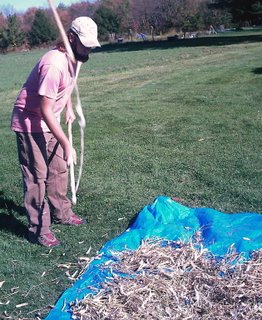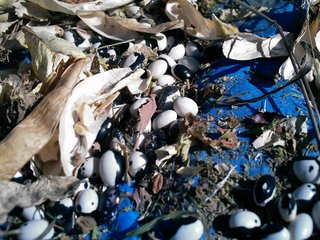
August 3, 2009
magazine articles, rain, and growth on the farm...

January 30, 2007
the bean lowdown
 jean's beans- bean varieties
jean's beans- bean varietiesJacob’s Cattle
This popular New England heirloom variety is also known as trout or Dalmation bean. This bean is excellent in soups and chili, and unsurpassed for baking.
Maine Sunset:
A wonderful baking bean, with a creamy texture and rich flavor when cooked . Also delicious in soups or pasta con fagioli.
Steuben:
Old-timey bean variety. Great baked or for use in soups and stews.
Brown Dutch:
Heirloom bean from Pennsylvania. Holds it's shape well, and has a nut-like flavor when baked. Also makes a great addition to soups.
Scarlet Beauty-SOLD OUT!!
New Hampshire Heirloom developed by Elwyn Meader. This mottled red and beige kidney-type bean is a knockout in chili.
Peregion:
Oregon heirloom. This truly unique bean keeps its color after cooking. Thin skinned and tender all-around bean.
Yin Yang:
Beautiful black and white markings resemble a Chinese Yin Yang. Excellent full flavor.
January 28, 2007
chilly bean field
 Winter has finally settled in and I must say it feels as though all is right with the world again. We are in the thick of January's seed-ordering frenzy. There's nothing like pouring over catalogs with a hot bowl of soup as the cold wind blows outside. One of the best aspects of farming is the ability to start from scratch every spring- tweaking, improving, trying new things. Who knows what wrench the weather will throw into the works! For now, I am content to enjoy the pleasantly brisk arctic air. Here's me on one of our coldest days walking on the frozen furrows of the future bean field.
Winter has finally settled in and I must say it feels as though all is right with the world again. We are in the thick of January's seed-ordering frenzy. There's nothing like pouring over catalogs with a hot bowl of soup as the cold wind blows outside. One of the best aspects of farming is the ability to start from scratch every spring- tweaking, improving, trying new things. Who knows what wrench the weather will throw into the works! For now, I am content to enjoy the pleasantly brisk arctic air. Here's me on one of our coldest days walking on the frozen furrows of the future bean field.
November 10, 2006
Simple Beans
This is more a preparation guideline than a recipe, though following these ingredients will produce wonderous results. However, substitutions in seasonings and stock are highly encouraged. This method allows the unique qualities of these heirloom variety local beans to come through. Since these beans are fresher by far than dried beans in the grocery store, they require less soaking time, less cooking time, and less seasoning.
Along with bread and a light salad, ample for four as a hearty meal.
1 1/2 cups dried beans
about 6 cups ham stock (made by simmering a ham bone in water for about 4 hours)
2 tbs olive oil
garlic – as much as you like, minced
onion – about a cup chopped
1/2 tsp rosemary
1/2 tsp marjoram
1/2 tsp thyme
1/2 tsp sage
1 tsp black pepper
(Poultry seasoning is a mix of the above ingredients. I prefer them separate, but if you have the powdered mixture on hand, by all means, use it.)
Soak the beans in water. These beans do not have to be soaked overnight, but should be soaked for about 6 hours. Longer is fine. Shorter is fine, too, the beans will simply need to cook longer. In a heavy pot, sauté the onion and garlic until soft, then add the beans and their soaking water. Add stock until the beans are covered by at least an inch. Cover. Simmer on low, occasionally stirring. Add more stock as necessary to provide enough moisture. After two hours, begin tasting the beans. They should be tender. The beans should have imparted a starchy thickness to the liquid, and much of it should have been absorbed by the beans or evaporated. The overall consistency will resemble very thick stew. Cook longer as needed, continuing to taste test for tenderness every 20 minutes or so, adding stock as needed. When they are close to being done, add the seasonings.


